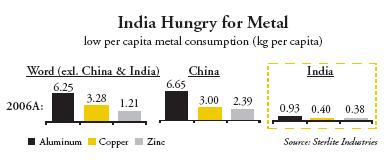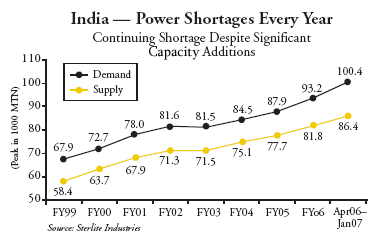| Home | About Us | Resources | Archive | Free Reports | Market Window |
The Sleeping Giant in the Commodities MarketBy
Saturday, March 15, 2008
February 2007 will go down as one of the greatest months the commodities market ever had. Only two months into the year, natural gas was up 26%, coal up 56%, and platinum up 41%. This in two months! Crude oil, gold, silver, corn, wheat, soybeans, coffee, and sugar hit new highs almost daily during the month. We know there are tons of all this stuff in this big ball of a planet we call home. The trouble is that you have to know how find it, get to it, and dig it out. Aye, there is the rub. As global demand explodes for nature's riches, it takes time for the market to deliver the goods. So, too, copper and aluminum were within striking distance of all-time highs in February. Believe it or not, the consensus heading into 2008 was that the unfolding global slowdown would take these metal prices lower. That certainly didn't happen. Some of the price rise was due to supply problems in China and South Africa. Producing these metals requires a lot of energy. Yet persistent blackouts and power issues plague producers in these countries. In any event, aluminum topped $3,000 per ton for the first time since May 2006. Copper hit $8,500 per ton, near all-time highs, as Chinese consumption remains high. Global copper inventory covers only about three days' worth of global consumption. With a market running that tight, prices remain susceptible to big spikes. Credit Suisse says copper could spike to $12,000 per ton, partly on the rising cost of sulfuric acid, which about a quarter of copper producers use to process copper ore. But the biggest driver behind metal prices such as copper and aluminum is the huge global demand for infrastructure. Morgan Stanley estimates that emerging markets will spend $21.7 trillion on infrastructure over the next 10 years. Power plants, roads, bridges, airports... A great way to play this infrastructure boom, I believe, is by owning low-cost copper producers. It's amazing how much copper emerging economies consume. We need look no further than China, which is sort of India fast-forward (in the sense that China began its liberalization in 1978, India only in 1991). China can give us something of a peek into what the future of Indian consumption might look like. In 1990, China imported 20,000 metric tons of copper. It now imports more than one million metric tons and is the world's largest consumer of copper. It's not surprising when you consider how much copper is tied to construction – particularly to housing and anything related to hooking up electrical connections and power stations. I see this demand boosting my Capital & Crisis portfolio holding ABB Ltd. (ABB), the world's biggest maker of electrical grids. India is the fifth-largest market for new orders for ABB. In the last quarter, new orders were up 42% in India. ABB claims its orders in India will double by 2010! Certainly, when you compare India's consumption of metal on a per-capita basis with that of other countries, you see enormous room for growth.
This is not idle wondering. This has real merit, like mixing vodka and tomato juice. Increased metal consumption is practically a given. India desperately needs more power. And India's government will spend billions of dollars adding around 600 gigawatts of electricity by 2030.
All of this infrastructure requires a lot of metal, especially copper. Hence, one of the hot growth sectors in India is its metals and minerals. Most investors tend to think of India's famous technology companies. But here is an industry still in the early stages of growth. India has substantial deposits of bauxite, iron ore, copper, zinc, and more. In some of these, India's reserves are among the largest in the world. With all the demand for metals both from India itself and abroad, India's production has ramped up significantly. Indian companies are also among the lowest-cost producers in the world. If you're interested in playing India as a whole, there are a handful of ETFs out there that give you direct exposure here. Probably my favorite way to invest in what's happening in India, however, is through select base-metals producers. The growth here has a long way to run. Good investing, Chris Mayer P.S. I just added the lowest-cost copper producer in the world to my Capital & Crisis advisory portfolio. It has incredible untapped assets located right in India. As India's appetite for metals aligns more with China's and the rest of the world's, I expect this company's profits and stock price to soar. Click here for the details.
Further Reading:
The $4,017 Hair Dryer Market NotesTHE WORLD'S MOST HATED MARKETS
Our chart of the week displays the world's most hated stock markets.
The P/E ratio of a stock market is the price investors will pay for a given unit of earnings. If the ratio is high, investors are optimistic and willing to pay a premium for a rosy outlook. If the ratio is low, investors are "pricing in" a poor outlook. In some cases, the reason for a low P/E is obvious. Would you invest in Venezuela right now? If your investment does well, Hugo Chavez may just nationalize it. In other cases, however, the reason isn't as clear. Take Singapore, for example. The World Bank has rated this small republic as the most business-friendly economy in the world. It's close to both China and India. It's one of Asia's largest banking hubs, and it's the world's busiest port in terms of tonnage shipped (as of 2006). So why are Singaporean stocks so cheap? Stock prices simply haven't kept up with earnings growth. Since June 2002, the Datastream Singapore index has soared 79%. However, earnings have increased even faster, causing the index's P/E to fall from 15.5 to its current level of 8.8. Value investors take note! – Ian Davis |
Recent Articles
|



